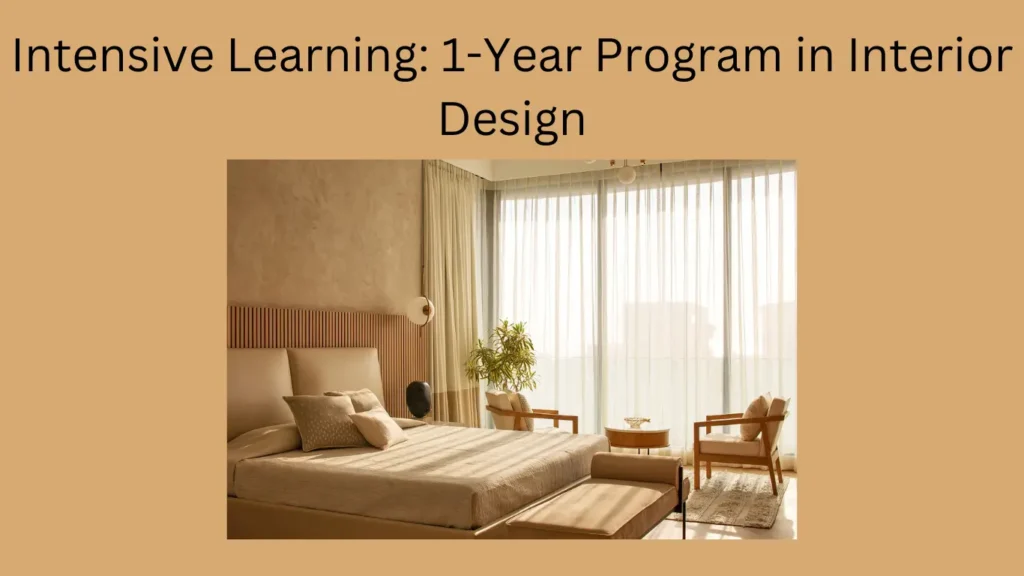Embarking on a 1-year program in interior design is a transformative journey that compresses the essence of design education into a concentrated and impactful timeframe. This guide is crafted with a people-first philosophy, providing insights into the unique aspects of a 1-year interior design program, the intensive learning experience it offers, and how it shapes individuals for success in the dynamic field of interior design.
The Essence of a 1-Year Interior Design Program
1. Accelerated Learning
The 1-year program is designed for individuals who seek an accelerated learning experience without compromising the depth of knowledge. It condenses traditional multi-year curricula into a comprehensive and focused format.
2. Practical Skill Development
An emphasis on practical skill development is a hallmark of the program. Students engage in hands-on projects, gaining real-world experience that prepares them for the challenges of the interior design industry.
Crafting a Comprehensive Curriculum: Program Highlights
1. Core Design Principles
The program covers core design principles, providing a solid foundation in areas such as spatial design, color theory, and furniture design. These principles serve as the building blocks for creative expression in interior spaces.
2. Specialized Modules
Specialized modules cater to the diverse facets of interior design. From residential and commercial design to sustainable practices and digital tools, students gain expertise in a spectrum of design areas, enhancing their versatility.
Nurturing Design Talents: A People-First Approach
1. Personalized Mentorship
The people-first approach is embedded in personalized mentorship. In a smaller and more intimate learning environment, students receive individualized guidance, ensuring their unique talents and aspirations are recognized and nurtured.
2. Collaborative Studio Environment
The program fosters a collaborative studio environment. Students work closely with peers, fostering a sense of community and collaboration that simulates the dynamics of a professional design studio.
Accelerating Career Paths: Opportunities Post-Graduation
1. Immediate Entry into the Workforce
A significant advantage of the 1-year program is the opportunity for immediate entry into the workforce. Graduates are equipped with practical skills and a comprehensive design portfolio that positions them for success in various design roles.
2. Industry Networking and Exposure
The program facilitates industry networking and exposure. Students benefit from interactions with industry professionals, guest lectures, and potential internship opportunities, providing a valuable bridge between education and the professional realm.
Navigating the 1-Year Interior Design Journey
1. Time Management and Focus
Time management and focus are critical for success in a condensed program. Students learn to prioritize tasks, manage deadlines, and cultivate a strong work ethic, valuable skills in the fast-paced design industry.
2. Continuous Learning Mindset
The 1-year program instills a continuous learning mindset. Graduates are prepared to adapt to emerging design trends, technologies, and methodologies throughout their careers, ensuring they remain competitive in the ever-evolving industry.
Conclusion: Crafting Design Futures in One Year
Pursuing a 1-year program in interior design is an intensive yet rewarding path to becoming a design professional. With a curriculum that balances depth and practicality, a people-first approach, and opportunities for immediate entry into the workforce, individuals can shape their design futures in a condensed timeframe.
FAQs
1. What distinguishes a 1-year interior design program from longer programs?
- A 1-year program offers an accelerated learning experience, condensing core design principles and specialized modules into a comprehensive curriculum for immediate entry into the workforce.
2. How does personalized mentorship contribute to the people-first approach?
- Personalized mentorship ensures individual talents and aspirations are recognized and nurtured, creating a supportive environment within the smaller and more intimate learning setting.
3. What career opportunities are available after completing a 1-year interior design program?
- Graduates can immediately enter the workforce equipped with practical skills and a comprehensive portfolio. Networking opportunities and exposure to industry professionals enhance career prospects.
4. How does the program balance depth and practicality in its curriculum?
- The program balances core design principles with practical skill development. Specialized modules cover various design areas, enhancing versatility and preparing students for real-world challenges.
5. How does the program instill a continuous learning mindset?
- The 1-year program instills a continuous learning mindset by preparing graduates to adapt to emerging design trends, technologies, and methodologies throughout their careers.

